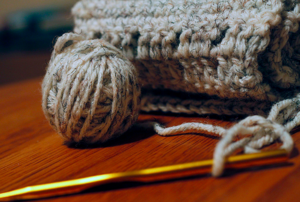
Crochet refers to the needlecraft that uses a crochet hook or hook and yarn to create garments, lace, soft furnishings, edges, blankets, covers, dishcloths, headwear, toys, baby wear and much more. The term crochet originated from the French word "croche" or hook. The art of crochet is known throughout the world, across many cultures.
Crochet can be very delicate and elaborate or plain and simple, suiting a range of projects that any person aiming to live self-sufficiently would find most useful. While it did experience a decline in the mid twentieth century, probably due to the availability of ready-made items in greater numbers, it became fashionable again from the 1960s and has proven to be a resilient craft that many people find both satisfying and useful.
Crochet tools[edit | edit source]
Hooks are a standard requirement for crochet. The hooks come in grades ranging from 0.75mm to 10.00mm, and the grades equate to the size of yarn used and the desired size of the crocheted piece. Larger hooks create more open, wider loops and are suitable for making such things as rugs and for using coarser materials, including plastic bags. Smaller hooks are ideal for delicate work with smaller holes and finer textures, including for lace.
Crochet hooks are often made from steel but can also be found in plastic, bakelite, bone, wood, wood and steel together, and bamboo, along with other materials. It's worth trying different ones to find your favorite. You'll find that bone hooks tend to be antique and can be found in antique stores or online.
A needle and scissors are generally handy for crocheting too, as you'll need to cut the yarn and possibly stitch the item created.
Crochet materials[edit | edit source]
Various yarns can be used for crochet. Typically, crochet cotton is sold in balls of varying ply amounts. The ply determines the texture of the final product. For example, twisted 6-ply crochet cotton is ideal for delicate lace, while 2-ply produces a thick result. Cotton perlé is another yarn suitable for crocheting with. Cotton double knitting yarn can be used for items that will get a lot of use such as bags and blankets.
Less common yarn forms can be crocheted too, such as plastic bags, plastic, raffia, metallic yarns, twine, etc. The utility of the yarn depends on the end use and the ease with which it can be crocheted. It never hurts to try a few different yarns to test their outcome.
Embroidery or cotton thread is often useful for stitching projects that require piecing together. Try to use matching colours.
Crochet terms[edit | edit source]
It is useful to learn the crochet terms when starting out in crochet, as the patterns are written using basic terminology. Some of the standard terms are:
- alt - alternate
- beg - beginning
- bet - between
- chs - chain or chain stitches
- cont - continue
- dc - double crochet
- rep - repeat
- sc - single crochet
- sk - skip
- tog - together
- tr - treble
- yo or yoh - yarn over hook
A chain forms the base for the crochet in all cases. Once a chain is created, it forms the foundation from which the rest of the creation is built on. Chain stitch is usually referred to by the shorthand of "ch".
Conversion chart[edit | edit source]
Crochet terms differ depending on whether a pattern is British or US in origin. This needs to be accounted for when learning crochet terminology and using patterns. For example, a British pattern will refer to yoh, meaning yarn over hook, whilst the US pattern would refer to yo or yarn over.
Gallery of things you can make using crochet[edit | edit source]
This gallery provides just a sampling of the many possibilities that a person can make using crochet.
-
Crocheted rug
-
Crocheted tote bag made from leftover yarn
-
Crocheted shawl or window covering
-
Crocheted box or basket
-
Crocheted hat
-
Crocheted art with nature
-
Three-dimensional (3D) crocheted bowl using recycled satin pillow
-
Crocheted toy sheep
-
Crocheted throw for baby or pet
-
Crocheted tree frog toy
-
Crocheted dish cloth










